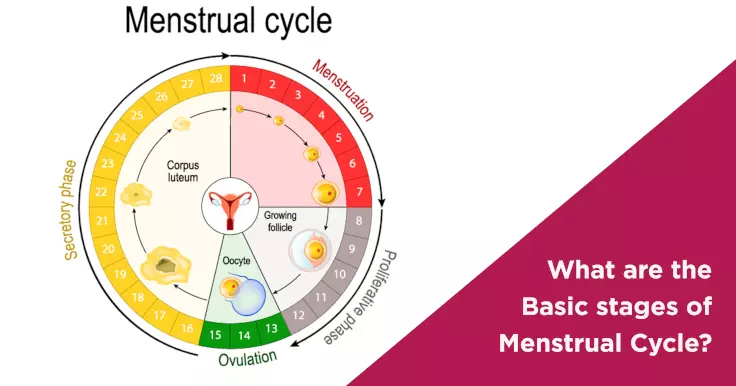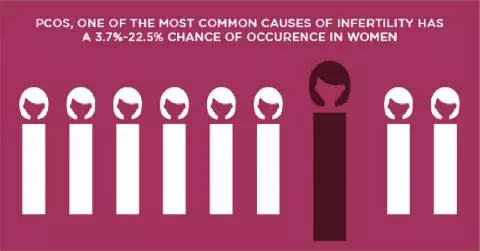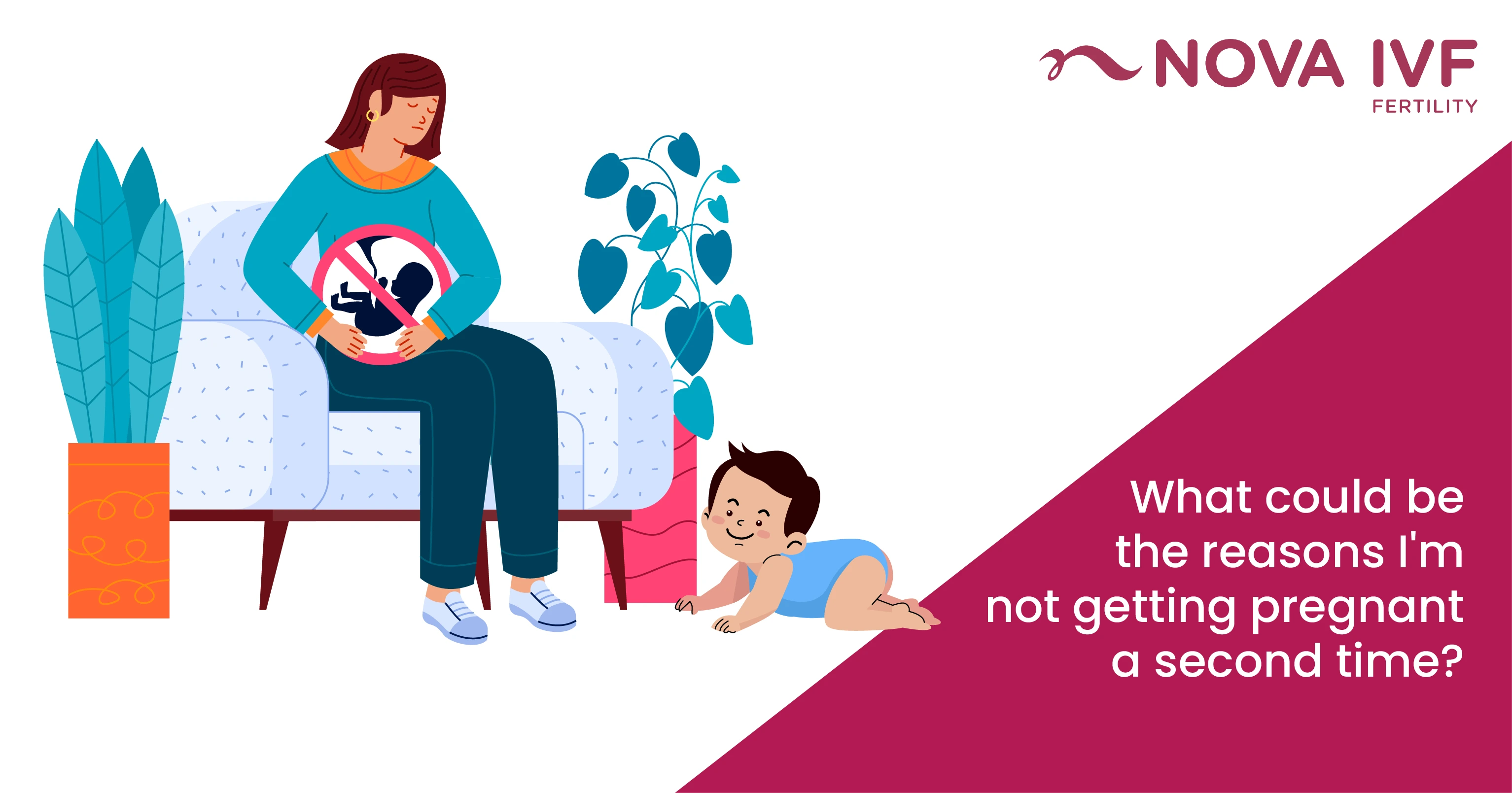Understanding the 4 Phases of the Menstrual Cycle & Its Stages

The menstrual cycle is a natural part of a woman’s life. It's a highly complex process taking place in your body with the help of hormones, which lead to regular bleeding, i.e., your periods. This cycle can be divided into four stages, namely menstruation, the follicular phase, ovulation, and the luteal phase.
Let’s understand what exactly is the menstrual cycle in detail. Basically, your menstrual cycle prepares your body to accommodate a foetus or pregnancy. If you don't get pregnant during a cycle, your hormones send signals to your uterus for shedding the uterine lining; this shedding is your period. This cycle repeats itself with each of your new periods.
A menstrual cycle is measured from the day one of a period to the day one of the subsequent period. On average, a menstrual cycle can be 21 to 35 days long; however, it varies from person to person.
The first ever period you get is menarche. In some countries, girls may get their first period at the age of 12 to 13 years; nevertheless, some girls may get their period as early as 9 years or as late as 16 years. If you're concerned about your period, it's a good idea to talk to your doctor.
The last period you have is called menopause. The average age for menopause is 51 to 52, but some women might not reach it until they're 60.
Menstrual cycle phases, Menstruation or more colloquially referred to as chums, periods, that time of the month, Aunt Flo, or even monthly visitor is one of the major phases a woman goes through during her childbearing years. A menstrual cycle is a natural process that generally happens to women every 28 to 35 days and which generally lasts till the age of 50. Let's take a look at all the four stages and the changes a female body goes through during menstrual periods.
Let’s understand the stages of menstrual cycle your body goes through during a cycle of period.
4 Basic Phases of Menstrual Cycle
1. Menstrual Phase or Menstruation
Menstruation, or getting your period, is the process in which your uterine lining sheds itself and exits through your vagina. This discharge includes mucus, blood, and cells from the lining of your uterus. A normal period lasts between three and seven days. During your period, you can use tampons, period underwear, sanitary pads, or menstrual cups to manage the flow. It's important to change pads and tampons every three to four hours, while menstrual cups should be emptied every eight to 12 hours.
Basically, during this stage, the uterus sheds its inner lining through the vagina in the form of fluid. Women generally have cramps caused due to the contraction of the uterine wall during this phase. Even though it seems like a lot of fluid is lost, the fluid loss in a menstrual cycle is typically 35 ml.
2. Follicular Phase
The follicular phase starts on the first day of your period and continues for about 13 to 14 days, ending with ovulation. During this phase, the pituitary gland in your brain releases a hormone that stimulates follicles on an ovary. Typically, only one follicle matures into an egg, usually around day 10 of your cycle. At the same time, your uterus lining thickens in preparation for a possible pregnancy.
So, the follicular phase starts simultaneously with the menstrual stage but ends on the 13th day. During this phase, the brain releases hormones in the blood to the ovaries which increases the production of follicles. From the 15 to 20 eggs that are generated in the ovaries, only one matures and continues producing the estrogenic hormone. Around the time of ovulation, the testosterone hormone is also released which increases a woman's libido.
3. Ovulation Phase
Ovulation takes place when a fully developed egg is released from your ovary and travels toward your uterus through the fallopian tube. This usually happens once a month, about two weeks before your next period, and lasts between 16 to 32 hours. You can get pregnant during the five days before ovulation and on the day of ovulation itself, with the highest chances in the three days leading up to and including ovulation. After being released, the egg survives for up to 24 hours, and if sperm reaches it during this time, pregnancy can occur.
Thus, the pituitary gland secretes a hormone that causes the ovary to release the matured egg cell. The released egg cell is swept into the fallopian tube by the cilia of the fimbriae. Fimbriae are finger like projections located at the end of the fallopian tube close to the ovaries, generally this happens on the 14th day but can differ from woman to woman. Sometimes women feel a slight cramp on the lower right abdomen as the egg is released. The mature egg will stay in the fallopian tube for one whole day. If sexual intercourse happens, the sperm cells make their way to the mature egg. If the egg is fertilised then it grows in the fallopian tube for about four days and slowly moves into the uterus on the 5th day. If the sperm cells fail to fertilise the egg, the egg slowly disintegrates.
4. Luteal Phase
After ovulation, the corpus luteum, a group of cells in the ovary, releases progesterone and a small amount of estrogenic. These hormones help thicken the uterine lining in case of pregnancy. If a fertilized egg implants in the uterine lining, the corpus luteum keeps producing progesterone to maintain the lining. If pregnancy doesn’t happen, the corpus luteum breaks down, progesterone levels fall, the uterine lining sheds, and the cycle starts again with menstruation.
That is to say this phase starts from the 15th day to the 28th day. If the egg is fertilised, progesterone is still produced to thicken the uterine lining for implantation to happen. After 14 days, HCG hormone is produced. However, if fertilisation doesn't take place, progesterone slowly reduces and the body will start preparing for the menstrual periods.
Anovulatory Cycles
Sometimes, you might not ovulate during your menstrual cycle. These are called anovulatory cycles. They’re pretty common in the first 12-18 months after you start having periods and also as you approach menopause. When you don’t ovulate, there’s usually no corpus luteum, so progesterone doesn’t affect your endometrium. Strogen still causes the endometrium to grow, though, and eventually, it becomes thick enough to break down and start shedding. The timing of the bleeding can vary, but it usually happens within 28 days of your last period. The flow can be inconsistent too, ranging from light to quite heavy.
Common Menstrual Problems
You might encounter several common menstrual issues, such as:
Premenstrual syndrome (PMS): Hormonal changes before your period can lead to various side effects, including headaches, fluid retention, irritability, and fatigue. You can manage these symptoms with exercise and dietary changes.
Dysmenorrhoea (painful periods): Certain hormones might cause your uterus to contract more intensely than needed to shed its lining, resulting in pain. Pain-relieving medication and oral contraceptives can help alleviate this.
Heavy menstrual bleeding (menorrhagia): Without treatment, heavy bleeding can lead to anaemia. Options to regulate the flow include oral contraceptives and a hormonal intrauterine device (IUD).
Amenorrhoea (absence of menstrual periods): This is abnormal outside of pre-puberty, pregnancy, lactation, and post menopause. Causes can include low or high body weight and excessive exercise.
You have about 450 periods in your lifetime, so it's really important to understand your menstrual cycle and how it works because it can come with various issues, consequences, and distress. If you have primary or secondary amenorrhea, you’ll need some clinical tests to find out why. However, these tests, which look at everything from your ovaries to your hypothalamus, can’t be done properly unless your doctor knows all about the hormone feedback system. You might also face problems like premenstrual syndrome, dysmenorrhea, or menorrhagia. Without knowing female anatomy and how the menstrual cycle works, your doctor can't get a full history and physical examination to understand what's going on. Infertility is a major concern nowadays, and since the menstrual cycle is how your body gets ready for pregnancy, your cycle needs to be checked if you're having trouble getting pregnant. You must understand your menstrual cycle completely to provide the best care to yourself.
In Conclusion
You should understand your menstrual cycle as is it has a huge influence on your body as well as mind. Each phase of your menstruation plays a vital role in preparing your body for a possible pregnancy. Thus, knowing what is happening may help you manage your health better.
Menstruation can come with discomfort and cramps, but it is important to understand that this indicates that your body is working as it should. By tracking your ovulation, which is typically around the middle of your cycle, you can plan your pregnancy effectively, as ovulation is the time when you're most fertile. In this way, you can even ensure that there is no unplanned pregnancy if you are not comfortable to have a child yet or wish to have a child in the future. With your period comes some common menstrual problems like painful cramps, PMS, heavy bleeding, and amenorrhea, which can affect your day-to-day life and/or health.
Knowing your cycle allows you to understand what’s normal for your body and if or when anything is off. It also helps you address issues like a missed period or heavy bleeding, which may indicate health problems.
Every woman's cycle is unique, and what’s normal for someone else could be a topic of concern for you. Therefore, it is important to consult your doctor regarding any issues you are facing, irrespective of how insignificant it may seem. Your doctor can offer a therapy plan and advice suitable to your needs.
 Infertility Counselling
Infertility Counselling Female Infertility Treatment
Female Infertility Treatment Andrology Treatment
Andrology Treatment Fertility Enhancing Surgeries - Female
Fertility Enhancing Surgeries - Female Fertility Enhancing Surgeries - Male
Fertility Enhancing Surgeries - Male Endoscopy Treatment
Endoscopy Treatment IUI Treatment
IUI Treatment IVF Treatment
IVF Treatment ICSI Treatment
ICSI Treatment Advanced IVF Solutions
Advanced IVF Solutions Embryology
Embryology Vitrification Egg, Embryo, Sperm Freezing
Vitrification Egg, Embryo, Sperm Freezing Preimplantation Genetic Testing (PGT)
Preimplantation Genetic Testing (PGT) Donation Program Embryo / Egg / Sperm
Donation Program Embryo / Egg / Sperm Self-cycleTM IVF
Self-cycleTM IVF

 Self-cycleTM IVF
Self-cycleTM IVF










